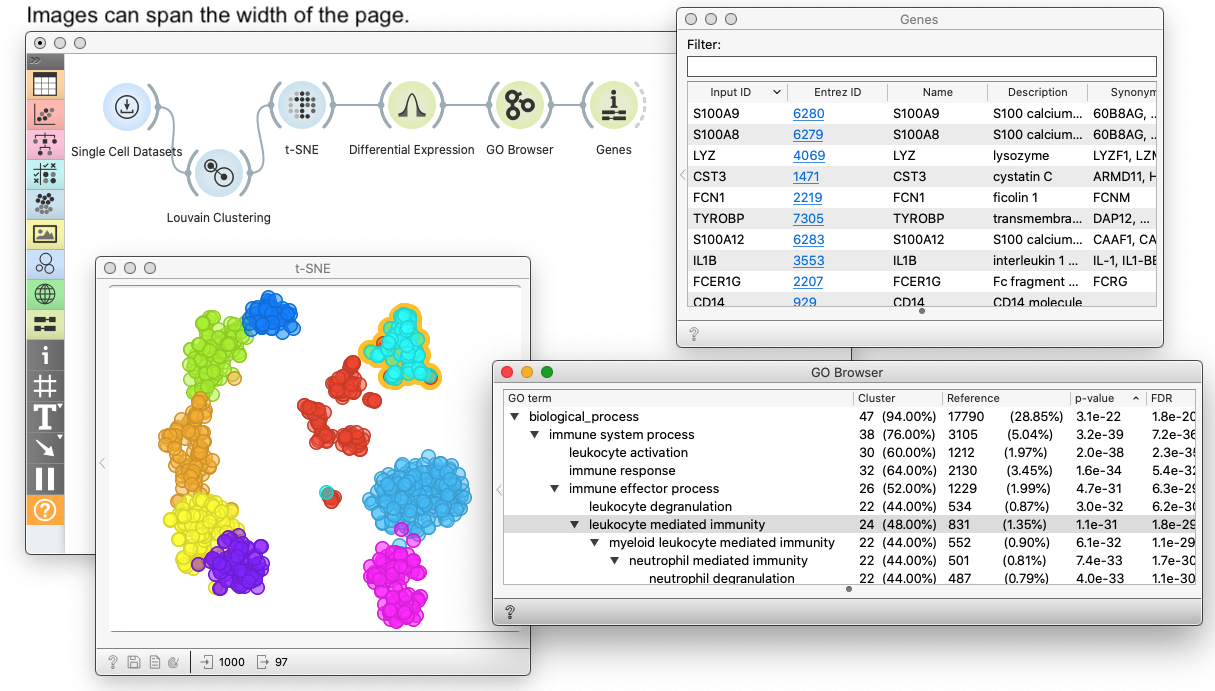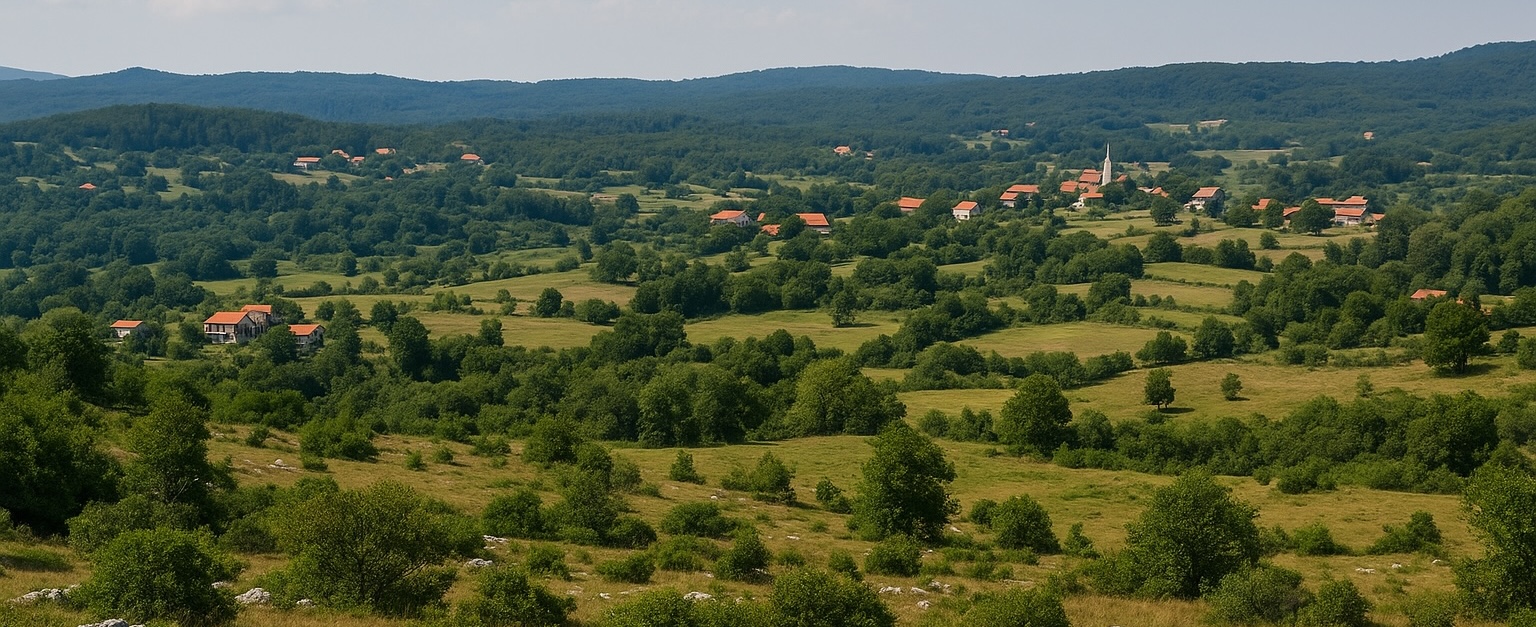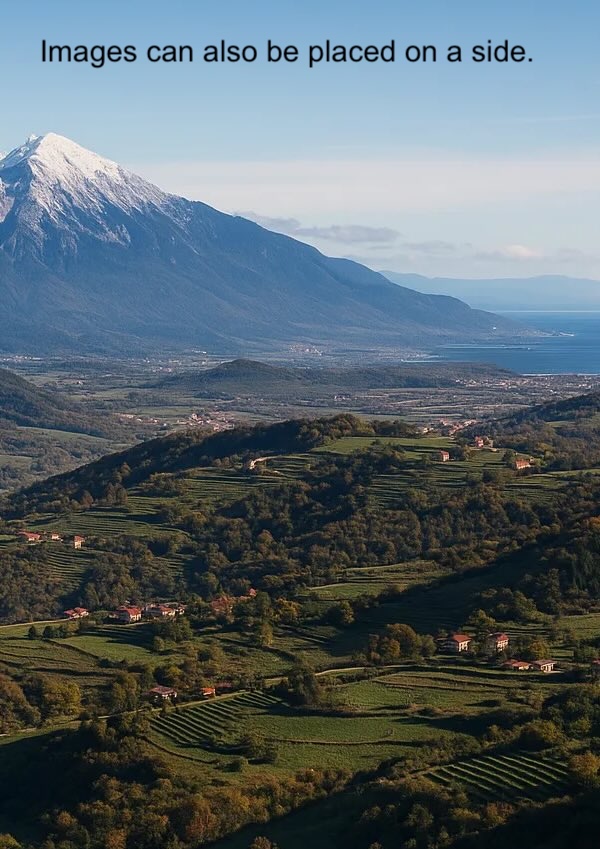About Slovenia
A Sample Textbook for InnovPrecMed Project
This is a cool sample textbook to demonstrate the structure and composition of lecture notes to be developed InnovPrecMed Project. It weaves together stories from the capital city of Ljubljana, the subterranean wonders of the Karst region, and the striking transition from the alpine north to the Adriatic coast. Each chapter explores how the natural environment and human heritage are deeply intertwined, offering a unique perspective on this small but remarkably varied country.
These sample notes were created by Blaž Zupan with a help of AI. The notes environment is developed by team at the Bioinformatics Lab, University of Ljubljana, Slovenia. The material is shared under the Creative Commons CC BY-NC-ND licence.

Chapter 1: Ljubljana
Ljubljana, the capital of Slovenia, is a city shaped by its river. The Ljubljanica, calm and winding, flows through the old town and gives rhythm to the daily life around it. It has been a trading route, a border, a muse for poets, and a setting for festivals. Today, it is the stage for both locals on bicycles and tourists strolling over its iconic bridges. Following are the main concepts covered in this chapter:
- Ljubljanica River: A central natural and cultural feature shaping the identity and layout of Ljubljana.
- Urban Landscape: The integration of natural elements like the river into the structure and rhythm of city life.
- Cultural Landmarks: The importance of bridges, squares, and riverside spaces in the everyday experience of Ljubljana.
- Jože Plečnik: Architect of many iconic structures in Ljubljana, influencing the city’s visual identity.
- University of Ljubljana: The city's academic center and a hub of research, tradition, and innovation.
- Orange Data Mining: A research-driven, open-source tool developed at the University of Ljubljana that reflects the city’s educational creativity.
The Ljubljanica originates in the karstic marshes and re-emerges seven times before reaching the city.
From its green banks to its cobbled quays, the river brings movement and symmetry to the city. The buildings lean in toward the water, their reflections shimmering in the summer light. Streets often curve to match the river’s gentle bends, and cafés position their terraces just close enough to dip a hand in the water.

One of the most recognizable scenes in Ljubljana is the Triple Bridge, or Tromostovje. Designed by Jože Plečnik, it connects the historical medieval town with the more modern city center. Standing there at twilight, when the lamps begin to glow and the air smells of roasted chestnuts, it’s easy to understand why so many fall in love with the city at first sight.
At the heart of Ljubljana, nestled between the old town and the leafy banks of the Ljubljanica, stands the University of Ljubljana—Slovenia’s largest and oldest academic institution. Among its many faculties and research groups is the renowned Faculty of Computer and Information Science, home to the development of Orange, an open-source data mining and visualization tool. Created in the spirit of accessible and intuitive data science, Orange combines the city’s academic rigor with its creative energy. The project, developed by researchers and students alike, reflects the university’s commitment to open knowledge and innovation.

To reflect on how the river, architecture, and innovation intertwine in shaping Ljubljana’s character, consider the following questions:
Which element best illustrates how the Ljubljanica River shapes city life in Ljubljana? (1pt.)
Which figure most significantly shaped the visual identity of Ljubljana through architecture? (1pt.)
Chapter 2: The Karst Region
Just a short drive south of Ljubljana lies one of Slovenia’s most mysterious and captivating regions: the Karst. Known for its dramatic limestone formations, underground rivers, and vast cave systems, the Karst is both a geological phenomenon and a cultural landscape shaped over millennia. This chapter takes us beneath the surface—literally and figuratively—exploring the quiet power of water, stone, and time. Following are the main concepts covered in this chapter:
- Karst Topography: A landscape defined by sinkholes, limestone plateaus, disappearing streams, and caves.
- Cave Systems: Natural underground networks like Postojna and Škocjan that reveal Slovenia’s subterranean richness.
- The Role of Water: How flowing water sculpts the terrain, from silent dripstones to roaring underground rivers.
- Cultural Life: Traditions, farming, and architecture that have adapted to the karst environment.
- Biodiversity: Endemic species and protected ecosystems found in caves and karst forests.
- Living with Stone: How local communities build, live, and thrive in the rocky terrain of southwestern Slovenia.
The term “karst” originates from the Slovene word kras, meaning rocky or bare land.
The Karst region is a place where the land hides more than it shows. Much of its character is underground—where rivers vanish, reappear, and carve out chambers large enough to hold cathedrals. Above ground, the rocky terrain is scattered with stone walls, dry valleys, and clusters of red-roofed villages. These are not dramatic mountains or lush plains, but a quietly rugged world where life clings with persistence.

Among the most famous of these hidden worlds is the Škocjan Caves, a UNESCO World Heritage Site. Here, visitors descend into a chasm where the Reka River roars through a limestone canyon far below ground. Bridges span the cave interior, and the air is cool and heavy with mineral scent. Deeper still, stalactites and stalagmites rise and fall like ancient guardians of a forgotten realm.
The Reka River disappears into the Škocjan Caves and travels underground for over 30 km before reemerging.
In contrast, Postojna Cave offers a more curated experience, complete with a cave railway that has carried curious visitors since 1872. Despite the electric lights and tour paths, the feeling of descending into the unknown remains powerful. Here lives the elusive olm, a pale, blind amphibian known locally as the "human fish," a creature that thrives in total darkness. Yet the Karst is not only a realm of caverns. Above ground, life unfolds slowly across a rocky, wind-swept terrain. The region is known for its terra rossa—a rich red soil ideal for vineyards—and for its hardy forests, shaped by dry summers and stony ground. Traditional life here reflects centuries of adaptation to the land’s demands and rewards.
Five distinctive features of the Karst region include:
- Vineyards rooted in shallow, mineral-rich soil producing unique dry wines.
- Pršut drying naturally in stone cellars under the cold burja wind.
- Oak and pine forests shaped by limestone outcrops and sparse rainfall.
- Dry stone walls built by hand to clear fields and mark boundaries.
- Low, thick-walled houses made of local stone, built to endure wind and time.
Time to check what we have just learned:
Which feature is most characteristic of karst topography? (1pt.)
What distinguishes the Škocjan Caves as a notable feature of the Karst region? (1pt.)
Which tradition reflects how people in the Karst region have adapted to their rocky environment? (1pt.)
Chapter 3: From Alps to Adriatic
Slovenia is a country where landscapes shift quickly and dramatically. In just a few hours, one can drive from high alpine peaks to gentle wine hills, from glacial lakes to a narrow but sunlit stretch of coast. This compact diversity is more than scenic—it shapes how people live, speak, eat, and celebrate. In this chapter, we follow a north-to-south journey, discovering how geography and culture intertwine across Slovenia. Following are the main concepts covered in this chapter:
- The Julian Alps: Towering mountains that define Slovenia’s northern identity and outdoor traditions.
- Gorenjska and Alpine Valleys: Villages nestled among peaks, shaped by history, weather, and stone.
- The Soča River Basin: A turquoise ribbon connecting rugged landscapes to memories of war and peace.
- The Wine Hills of the Vipava and Goriška Brda: Rolling hills where Mediterranean and alpine climates meet.
- The Slovene Littoral: A small but vivid coastline, blending Slavic, Italian, and Istrian elements.
Mount Triglav, at 2,864 meters, is Slovenia’s highest peak and a national symbol featured on the flag.
We begin in the Julian Alps, where Mount Triglav rises above steep valleys and glacial lakes. The highland region of Gorenjska is dotted with wooden hayracks and steep-roofed houses built to endure deep snow. Here, alpine traditions remain strong—from mountain dairy farms to the ringing of cowbells in summer pastures. The town of Bled, with its island church and cliffside castle, draws visitors with postcard beauty, but for locals, it is part of a lived landscape of trails, forests, and alpine lakes.
Southwest of the Alps lies the Soča River, whose clear blue-green water winds through gorges and beneath suspension bridges. The valley it shapes is known both for its natural beauty and for the tragic history of World War I’s Isonzo Front. Today, hikers and kayakers follow the same riverbanks that once echoed with artillery. Towns like Kobarid and Tolmin blend solemnity and vitality, with museums, memorials, and local festivals coexisting in the same narrow streets.
The Soča River’s color is caused by limestone particles suspended in glacial meltwater.
Descending further, the land begins to soften. Forests give way to vineyards, stone houses to tiled roofs. In Vipava Valley and Goriška Brda, fruit trees and vines stretch across sunlit slopes. The architecture turns Mediterranean—shuttered windows, whitewashed walls, and courtyards filled with rosemary and fig trees. These are places of long lunches, local wine, and gentle hills that rise just enough to offer a view of the sea on clear days.

Finally, the journey arrives at Slovenia’s small but richly layered coast. Just a few towns—Koper, Izola, and Piran—line the Adriatic, but each holds centuries of history. Narrow alleys, Venetian bell towers, salt pans, and seafood stalls reflect a deep connection to both land and sea. Piran, with its oval-shaped main square and fading stone facades, feels at once familiar and entirely singular.
The transition from alpine to coastal is not just topographical—it’s a movement through dialects, recipes, building styles, and rhythms of life. To cross Slovenia from the Alps to the Adriatic is to experience a quiet richness, where difference lives side by side and beauty takes many forms.
To review your knowledge about Slovenia, consider answering the following set of questions: